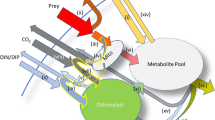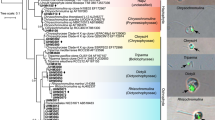Abstract
Planktonic algae <5 μm in size are major fixers of inorganic carbon in the ocean1. They dominate phytoplankton biomass in post-bloom, stratified oceanic temperate waters2. Traditionally, large and small algae are viewed as having a critical growth dependence on inorganic nutrients, which the latter can better acquire at lower ambient concentrations owing to their higher surface area to volume ratios3,4. Nonetheless, recent phosphate tracer experiments in the oligotrophic ocean5 have suggested that small algae obtain inorganic phosphate indirectly, possibly through feeding on bacterioplankton. There have been numerous microscopy-based studies of algae feeding mixotrophically6,7 in the laboratory8,9,10 and field11,12,13,14, as well as mathematical modelling of the ecological importance of mixotrophy15. However, because of methodological limitations16 there has not been a direct comparison of obligate heterotrophic and mixotrophic bacterivory. Here we present direct evidence that small algae carry out 40–95% of the bacterivory in the euphotic layer of the temperate North Atlantic Ocean in summer. A similar range of 37–70% was determined in the surface waters of the tropical North-East Atlantic Ocean, suggesting the global significance of mixotrophy. This finding reveals that even the smallest algae have less dependence on dissolved inorganic nutrients than previously thought, obtaining a quarter of their biomass from bacterivory. This has important implications for how we perceive nutrient acquisition and limitation of carbon-fixing protists as well as control of bacterioplankton in the ocean.
This is a preview of subscription content, access via your institution
Access options
Subscribe to this journal
Receive 51 print issues and online access
$199.00 per year
only $3.90 per issue
Buy this article
- Purchase on Springer Link
- Instant access to full article PDF
Prices may be subject to local taxes which are calculated during checkout

Similar content being viewed by others
References
Li, W. K. W. Primary production of prochlorophytes, cyanobacteria, and eukaryotic ultraphytoplankton — measurements from flow cytometric sorting. Limnol. Oceanogr. 39, 169–175 (1994)
Tarran, G. A., Zubkov, M. V., Sleigh, M. A., Burkill, P. H. & Yallop, M. Microbial community structure and standing stocks in the NE Atlantic in June and July of 1996. Deep-Sea Res. II 48, 963–985 (2001)
Malone, T. C. in The Physiological Ecology of Phytoplankton (ed. Morris, I.) 433–463 (Blackwell Scientific, 1980)
Chisholm, S. W. in Primary Productivity and Biogeochemical Cycles in the Sea (eds Falkowski, P. G. & Woodhead, A. D.) 213–237 (Plenum, 1992)
Zubkov, M. V. et al. Microbial control of phosphate in the nutrient-depleted North Atlantic subtropical gyre. Environ. Microbiol. 9, 2079–2089 (2007)
Caron, D. A. in Microbial Ecology of the Oceans (ed. Kirchman, D.) 495–523 (Wiley & Sons, 2000)
Jones, R. I. Mixotrophy in planktonic protists: an overview. Freshwater Biol. 45, 219–226 (2000)
Rothhaupt, K. O. Laboratory experiments with a mixotrophic chrysophyte and obligately phagotrophic and phototrophic competitors. Ecology 77, 716–724 (1996)
Stibor, H. & Sommer, U. Mixotrophy of a photosynthetic flagellate viewed from an optimal foraging perspective. Protist 154, 91–98 (2003)
Hansen, P. J. & Hjorth, M. Growth and grazing responses of Chrysochromulina ericina (Prymnesiophyceae): the role of irradiance, prey concentration and pH. Mar. Biol. 141, 975–983 (2002)
Bird, D. F. & Kalff, J. Bacterial grazing by planktonic lake algae. Science 231, 493–495 (1986)
Arenovski, A. L., Lim, E. L. & Caron, D. A. Mixotrophic nanoplankton in oligotrophic surface waters of the Sargasso Sea may employ phagotrophy to obtain major nutrients. J. Plankton Res. 17, 801–820 (1995)
Tittel, J. et al. Mixotrophs combine resource use to outcompete specialists: implications for aquatic food webs. Proc. Natl Acad. Sci. USA 100, 12776–12781 (2003)
Unrein, F., Massana, R., Alonso-Saez, L. & Gasol, J. M. Significant year-round effect of small mixotrophic flagellates on bacterioplankton in an oligotrophic coastal system. Limnol. Oceanogr. 52, 456–469 (2007)
Thingstad, T. F., Havskum, H., Garde, K. & Riemann, B. On the strategy of “eating your competitor”: A mathematical analysis of algal mixotrophy. Ecology 77, 2108–2118 (1996)
Vaque, D., Gasol, J. M. & Marrase, C. Grazing rates on bacteria — the significance of methodology and ecological factors. Mar. Ecol. Prog. Ser. 109, 263–274 (1994)
Zubkov, M. V. & Sleigh, M. A. Ingestion and assimilation by marine protists fed on bacteria labeled with radioactive thymidine and leucine estimated without separating predator and prey. Microb. Ecol. 30, 157–170 (1995)
Zubkov, M. V. & Sleigh, M. A. Assimilation efficiency of Vibrio bacterial protein biomass by the flagellate Pteridomonas: Assessment using flow cytometric sorting. FEMS Microbiol. Ecol. 54, 281–286 (2005)
Zubkov, M. V., Tarran, G. A. & Fuchs, B. M. Depth related amino acid uptake by Prochlorococcus cyanobacteria in the Southern Atlantic tropical gyre. FEMS Microbiol. Ecol. 50, 153–161 (2004)
Fagerbakke, K. M., Heldal, M. & Norland, S. Content of carbon, nitrogen, oxygen, sulfur and phosphorus in native aquatic and cultured bacteria. Aquat. Microb. Ecol. 10, 15–27 (1996)
Sherr, B. F., Sherr, E. B. & Fallon, R. D. Use of monodispersed, fluorescently labeled bacteria to estimate in situ protozoan bacterivory. Appl. Environ. Microbiol. 53, 958–965 (1987)
Zubkov, M. V., Sleigh, M. A. & Burkill, P. H. Measurement of bacterivory by protists in open ocean waters. FEMS Microbiol. Ecol. 27, 85–102 (1998)
Sherr, E. B. & Sherr, B. F. Significance of predation by protists in aquatic microbial food webs. Antonie Van Leeuwenhoek 81, 293–308 (2002)
Marie, D., Partensky, F., Jacquet, S. & Vaulot, D. Enumeration and cell cycle analysis of natural populations of marine picoplankton by flow cytometry using the nucleic acid stain SYBR Green I. Appl. Environ. Microbiol. 63, 186–193 (1997)
Mary, I. et al. Light enhanced amino acid uptake by dominant bacterioplankton groups in surface waters of the Atlantic Ocean. FEMS Microbiol. Ecol. 63, 36–45 (2008)
Zubkov, M. V., Burkill, P. H. & Topping, J. N. Flow cytometric enumeration of DNA-stained oceanic planktonic protists. J. Plankton Res. 29, 79–86 (2007)
Olson, R. J., Zettler, E. R. & DuRand, M. D. in Handbook of Methods in Aquatic Microbial Ecology (eds Kemp, P. F., Sherr, B. F., Sherr, E. B. & Cole, J. J.) 175–186 (Lewis, 1993)
Zubkov, M. V. & Burkill, P. H. Syringe pumped high speed flow cytometry of oceanic phytoplankton. Cytometry A 69A, 1010–1019 (2006)
Acknowledgements
We gratefully acknowledge the captain, officers and crew aboard the RRS Discovery for their help during the cruises, M. Moore for sharing chlorophyll concentration measurements, P. Hill for helping with setting up experiments on the second cruise, and P. Warwick for his help with radiotracer measurements ashore. We thank M. Sleigh, A. Martin and R. Leakey for their critical comments on the earlier drafts of the paper. We thank H. Ducklow for constructive criticism of the earlier version of this paper. This study was supported by the UK Natural Environment Research Council (NERC) through the Oceans 2025 core programmes of the National Oceanography Centre, Southampton and Plymouth Marine Laboratory. The second cruise was supported by the NERC thematic programme Surface Ocean Low Atmosphere Study (SOLAS).
Author Contributions The experimental approach was designed by M.Z., who carried out the tracer work. Flow cytometric analyses were done by G.T. and M.Z., respectively, on the first and second cruise.
Author information
Authors and Affiliations
Corresponding author
Supplementary information
Supplementary Information
The file contains Supplementary Figures 1-9 with Legends. (PDF 576 kb)
PowerPoint slides
Rights and permissions
About this article
Cite this article
Zubkov, M., Tarran, G. High bacterivory by the smallest phytoplankton in the North Atlantic Ocean. Nature 455, 224–226 (2008). https://doi.org/10.1038/nature07236
Received:
Accepted:
Published:
Issue Date:
DOI: https://doi.org/10.1038/nature07236
This article is cited by
-
Community dynamics of microbial eukaryotes in intertidal mudflats in the hypertidal Bay of Fundy
ISME Communications (2023)
-
Low rates of bacterivory enhances phototrophy and competitive advantage for mixoplankton growing in oligotrophic waters
Scientific Reports (2023)
-
Top-down structuring of freshwater bacterial communities by mixotrophic flagellates
ISME Communications (2023)
-
Adaptive carbon export response to warming in the Sargasso Sea
Nature Communications (2022)
-
Single-cell measurements and modelling reveal substantial organic carbon acquisition by Prochlorococcus
Nature Microbiology (2022)
Comments
By submitting a comment you agree to abide by our Terms and Community Guidelines. If you find something abusive or that does not comply with our terms or guidelines please flag it as inappropriate.



